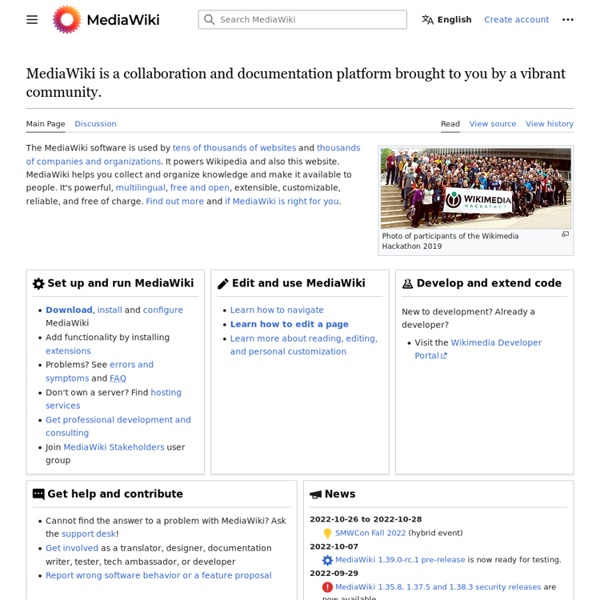



https://www.mediawiki.org/wiki/MediaWiki
WindLight settings From Second Life Wiki Resident-created WindLight settings Made WindLight settings you wanna share? Add 'em here! Snapz Pro X I have used sooo many different screen capture softwares and I just have to tell you guys that you are the ONLY ones who dont slow down my computer while recording video. Sometimes I have to check that the program is still on because I dont even believe it could work that well. Thank you!!! Andrew Smith, Customer Snapz Pro X is a nicely wrought utility that puts all other screen-capture methods to shame. If your Mac OS X work requires precise screen captures, Snapz Pro X is a must-have tool.
The Open Source Community How to - Digital Factory DEMO Pack (Enterprise Distribution) The Digital Factory Demo Pack is the best way to get our beautiful ACME Space DEMO without any application / database installation. Discover the beautiful authoring interface of Digital Factory. As a production like installation, the Jahia Studio is not available on this package setup. To install the Digital Factory DEMO Pack: eDonkey network The eDonkey Network (also known as the eDonkey2000 network or eD2k) is a decentralized, mostly server-based, peer-to-peer file sharing network best suited to share big files among users, and to provide long term availability of files. Like most sharing networks, it is decentralized, as there is not any central hub for the network; also, files are not stored on a central server but are exchanged directly between users based on the peer-to-peer principle. Currently, the eD2k network is not supported by any organization (in the past it was supported by the MetaMachine Corporation, its creator, which now is out of business) and development and maintenance is being fully provided by its community and client developers.
Save Yourself from Drowning in Online Interaction Rita-Marie Conrad Instructional Designer Florida State University Introduction "My email is killing me! Do you know how often students send me email?" SL Machinima Janine "Iris Ophelia" Hawkins' ongoing review of gaming and virtual world style It's been a little while since we checked in with Second Life mini doc-maker Draxtor Despres, but that isn't to say he hasn't been busy. The latest episode of his series of mixed-reality resident profiles, The Drax Fles: World Makers, went up recently, and features yet another incredibly interesting creator that many of us may never have heard of.
Free Software Overview Game Blocks is a free, open source library for making games. A purely visual programming toolkit, it was built with BYOB (Build Your Own Blocks) from UC Berkeley, which is built on top of Scratch. Scratch is developed by the Lifelong Kindergarten group at the MIT Media Lab.See Game Blocks was developed as a teaching aid by game developer Sheldon Pacotti for a course at the University of Texas entitled "RTF 344M: Writing and Narrative Design for Video Games." (See the syllabus.)
DokuWiki] DokuWiki is a simple to use and highly versatile Open Source wiki software that doesn't require a database. It is loved by users for its clean and readable syntax. The ease of maintenance, backup and integration makes it an administrator's favorite. Built in access controls and authentication connectors make DokuWiki especially useful in the enterprise context and the large number of plugins contributed by its vibrant community allow for a broad range of use cases beyond a traditional wiki. Onswipe Imagine waiting for the train while picking out your groceries from a display case filled with products identical in size, scale and color to really grocery store shelves. If the first round of the digital revolution was about making the real virtual, this time it is about making the virtual real again. South Korean grocery chain Tesco was looking for a way to one-up their major competitor – impossible to do in terms of physical shops due to a lack of actual stores; hence, they turned toward the world wide web with a combination of mobile phone and QR code technologies. Using smartphones, shoppers can browse the isles during time normally spent idle anyway on their way to or from work. Their purchased products are then delivered by the store, waiting for them when they get home and ready to be put right into the kitchen cabinets, refrigerator or freezer.